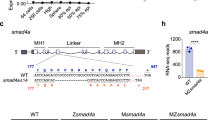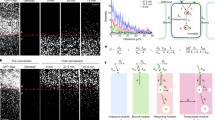Abstract
In many instances during development, morphogens specify cell fates by forming concentration gradients. In the Drosophila melanogaster wing imaginal disc, Decapentaplegic (Dpp), a bone morphogenetic protein (BMP), functions as a long-range morphogen to control patterning and growth1. Dpp is secreted from a stripe of cells at the anterior-posterior compartment boundary and spreads into both compartments to generate a characteristic BMP activity gradient2,3,4,5,6. Ever since the identification of the morphogen activity of Dpp in the developing wing, the system has served as a paradigm to understand how long-range gradients are established and how cells respond to such gradients. Here we reveal the tight and direct connection of these two processes with the identification and characterization of pentagone (pent), a transcriptional target of BMP signalling encoding a secreted regulator of the pathway. Absence of pent in the wing disc causes a severe contraction of the BMP activity gradient resulting in patterning and growth defects. We show that Pent interacts with the glypican Dally to control Dpp distribution and provide evidence that proper establishment of the BMP morphogen gradient requires the inbuilt feedback loop embodied by Pent.
This is a preview of subscription content, access via your institution
Access options
Subscribe to this journal
Receive 12 print issues and online access
$209.00 per year
only $17.42 per issue
Buy this article
- Purchase on Springer Link
- Instant access to full article PDF
Prices may be subject to local taxes which are calculated during checkout





Similar content being viewed by others
References
Affolter, M. & Basler, K. The Decapentaplegic morphogen gradient: from pattern formation to growth regulation. Nat. Rev. Genet. 8, 663–674 (2007).
Teleman, A. A. & Cohen, S. M. Dpp gradient formation in the Drosophila wing imaginal disc. Cell 103, 971–980 (2000).
Entchev, E. V., Schwabedissen, A. & Gonzalez-Gaitan, M. Gradient formation of the TGF-β homolog Dpp. Cell 103, 981–991 (2000).
Khalsa, O., Yoon, J. W., Torres-Schumann, S. & Wharton, K. A. TGF-β/BMP superfamily members, Gbb-60A and Dpp, cooperate to provide pattern information and establish cell identity in the Drosophila wing. Development 125, 2723–2734 (1998).
Lecuit, T. et al. Two distinct mechanisms for long-range patterning by Decapentaplegic in the Drosophila wing. Nature 381, 387–393 (1996).
Nellen, D., Burke, R., Struhl, G. & Basler, K. Direct and long-range action of a DPP morphogen gradient. Cell 85, 357–368 (1996).
Pyrowolakis, G., Hartmann, B., Muller, B., Basler, K. & Affolter, M. A simple molecular complex mediates widespread BMP-induced repression during Drosophila development. Dev. Cell. 7, 229–240 (2004).
Wu, M. Y. & Hill, C. S. TGF-β superfamily signaling in embryonic development and homeostasis. Dev. Cell. 16, 329–343 (2009).
Feng, X. H. & Derynck, R. Specificity and versatility in TGF-β signaling through Smads. Annu. Rev. Cell Dev. Biol. 21, 659–693 (2005).
Gao, S., Steffen, J. & Laughon, A. Dpp-responsive silencers are bound by a trimeric Mad-Medea complex. J. Biol. Chem. 280, 36158–36164 (2005).
Campbell, G. & Tomlinson, A. Transducing the Dpp morphogen gradient in the wing of Drosophila: regulation of Dpp targets by brinker. Cell 96, 553–562 (1999).
Jazwinska, A., Kirov, N., Wieschaus, E., Roth, S. & Rushlow, C. The Drosophila gene brinker reveals a novel mechanism of Dpp target gene regulation. Cell 96, 563–573 (1999).
Muller, B., Hartmann, B., Pyrowolakis, G., Affolter, M. & Basler, K. Conversion of an extracellular Dpp/BMP morphogen gradient into an inverse transcriptional gradient. Cell 113, 221–233 (2003).
Minami, M., Kinoshita, N., Kamoshida, Y., Tanimoto, H. & Tabata, T. brinker is a target of Dpp in Drosophila that negatively regulates Dpp-dependent genes. Nature 398, 242–246 (1999).
Blair, S. S. Wing vein patterning in Drosophila and the analysis of intercellular signaling. Annu. Rev. Cell Dev. Biol. 23, 293–319 (2007).
Tanimoto, H., Itoh, S., ten Dijke, P. & Tabata, T. Hedgehog creates a gradient of DPP activity in Drosophila wing imaginal discs. Mol. Cell 5, 59–71 (2000).
Weiss, A. et al. A conserved activation element in BMP signaling during Drosophila development. Nat. Struct. Mol. Biol. 17, 69–76 (2010).
Tsuneizumi, K. et al. Daughters against dpp modulates dpp organizing activity in Drosophila wing development. Nature 389, 627–631 (1997).
Strigini, M. & Cohen, S. M. Wingless gradient formation in the Drosophila wing. Curr. Biol. 10, 293–300 (2000).
Akiyama, T. et al. Dally regulates Dpp morphogen gradient formation by stabilizing Dpp on the cell surface. Dev. Biol. 313, 408–419 (2008).
Belenkaya, T. Y. et al. Drosophila Dpp morphogen movement is independent of dynamin-mediated endocytosis but regulated by the glypican members of heparan sulphate proteoglycans. Cell 119, 231–244 (2004).
Miaczynska, M., Pelkmans, L. & Zerial, M. Not just a sink: endosomes in control of signal transduction. Curr. Opin. Cell Biol. 16, 400–406 (2004).
Lecuit, T. & Cohen, S. M. Dpp receptor levels contribute to shaping the Dpp morphogen gradient in the Drosophila wing imaginal disc. Development 125, 4901–4907 (1998).
Lin, X. Functions of heparan sulphate proteoglycans in cell signaling during development. Development 131, 6009–6021 (2004).
Kirkpatrick, C. A. & Selleck, S. B. Heparan sulphate proteoglycans at a glance. J. Cell Sci. 120, 1829–1832 (2007).
Bornemann, D. J., Duncan, J. E., Staatz, W., Selleck, S. & Warrior, R. Abrogation of heparan sulphate synthesis in Drosophila disrupts the Wingless, Hedgehog and Decapentaplegic signaling pathways. Development 131, 1927–1938 (2004).
Fujise, M. et al. Dally regulates Dpp morphogen gradient formation in the Drosophila wing. Development 130, 1515–1522 (2003).
Hileman, R. E., Fromm, J. R., Weiler, J. M. & Linhardt, R. J. Glycosaminoglycan-protein interactions: definition of consensus sites in glycosaminoglycan binding proteins. Bioessays 20, 156–167 (1998).
Groppe, J. et al. Biochemical and biophysical characterization of refolded Drosophila DPP, a homolog of bone morphogenetic proteins 2 and 4. J. Biol. Chem. 273, 29052–29065 (1998).
Ohkawara, B., Iemura, S., ten Dijke, P. & Ueno, N. Action range of BMP is defined by its N-terminal basic amino acid core. Curr. Biol. 12, 205–209 (2002).
Crickmore, M. A. & Mann, R. S. Hox control of morphogen mobility and organ development through regulation of glypican expression. Development 134, 327–334 (2007).
Glise, B. et al. Shifted, the Drosophila ortholog of Wnt inhibitory factor-1, controls the distribution and movement of Hedgehog. Dev. Cell. 8, 255–266 (2005).
Gorfinkiel, N., Sierra, J., Callejo, A., Ibanez, C. & Guerrero, I. The Drosophila ortholog of the human Wnt inhibitor factor Shifted controls the diffusion of lipid-modified Hedgehog. Dev. Cell. 8, 241–253 (2005).
Kornberg, T. B. & Guha, A. Understanding morphogen gradients: a problem of dispersion and containment. Curr. Opin. Genet. Dev. 17, 264–271 (2007).
Entchev, E. V. & Gonzalez-Gaitan, M. A. Morphogen gradient formation and vesicular trafficking. Traffic 3, 98–109 (2002).
Perrimon, N. & McMahon, A. P. Negative feedback mechanisms and their roles during pattern formation. Cell 97, 13–16 (1999).
Freeman, M. Feedback control of intercellular signalling in development. Nature 408, 313–319 (2000).
Umulis, D., O'Connor, M. B. & Blair, S. S. The extracellular regulation of bone morphogenetic protein signaling. Development 136, 3715–3728 (2009).
Thomas, J. T., Canelos, P., Luyten, F. P. & Moos, M., Jr. Xenopus SMOC-1 inhibits bone morphogenetic protein signaling downstream of receptor binding and is essential for postgastrulation development in Xenopus. J. Biol. Chem. 284, 18994–19005 (2009).
Parks, A. L. et al. Systematic generation of high-resolution deletion coverage of the Drosophila melanogaster genome. Nat. Genet. 36, 288–292 (2004).
Kosman, D. et al. Multiplex detection of RNA expression in Drosophila embryos. Science 305, 846 (2004).
Bischof, J., Maeda, R. K., Hediger, M., Karch, F. & Basler, K. An optimized transgenesis system for Drosophila using germ-line-specific phiC31 integrases. Proc. Natl Acad. Sci. USA 104, 3312–3317 (2007).
Barolo, S., Castro, B. & Posakony, J. W. New Drosophila transgenic reporters: insulated P-element vectors expressing fast-maturing RFP. Biotechniques 36, 436–442 (2004).
Bakkers, J., Hild, M., Kramer, C., Furutani-Seiki, M. & Hammerschmidt, M. Zebrafish DeltaNp63 is a direct target of Bmp signaling and encodes a transcriptional repressor blocking neural specification in the ventral ectoderm. Dev. Cell 2, 617–627 (2002).
Kelley, C., Yee, K., Harland, R. & Zon, L. I. Ventral expression of GATA-1 and GATA-2 in the Xenopus embryo defines induction of hematopoietic mesoderm. Dev. Biol. 165, 193–205 (1994).
Joly, J. S., Joly, C., Schulte-Merker, S., Boulekbache, H. & Condamine, H. The ventral and posterior expression of the zebrafish homeobox gene eve1 is perturbed in dorsalized and mutant embryos. Development 119, 1261–1275 (1993).
Li, Y., Allende, M. L., Finkelstein, R. & Weinberg, E. S. Expression of two zebrafish orthodenticle-related genes in the embryonic brain. Mech. Dev. 48, 229–244 (1994).
Nikaido, M. et al. Tbx24, encoding a T-box protein, is mutated in the zebrafish somite-segmentation mutant fused somites. Nat. Genet. 31, 195–199 (2002).
Acknowledgements
We thank K. Basler, H. Nakato, S. Eaton, N. Perrimon, T. Kornberg, W. Gehring, J.P. Vincent, O. Shimmi and the Bloomington Stock Centre for fly lines, E. Laufer and T. Jessell for the pMad antibody and F. Bonath for technical assistance. We are indebted to B. Müller and K. Basler for sharing unpublished data at initial stages of the project. We are grateful to W. Driever, B. Hartmann, F. Hamaratoglou and M. Simons for comments on the manuscript, A. Weiss for suggesting the name pentagone and the Life Imaging Facility of SFB592 for technical support. Work in the laboratory of M.A. was supported by the Kantons Basel-Stadt and Basel-Land, by the Swiss National Science Foundation and by SystemsX.ch within the framework of the wingX RTD. A.S. was supported by a fellowship of Research Training Program GRK1104 and by the Spemann Graduate School of Biology and Medicine. Research in the G.P. laboratory was funded by a grant of the DFG collaborative research centre SFB592.
Author information
Authors and Affiliations
Contributions
R.V., A.S., S.K. and G.P. performed and analysed experiments. L.P. and M.H. contributed the zebrafish experiments. R.V., M.H., M.A. and G.P. designed and supervised experiments. G.P. wrote the manuscript.
Corresponding author
Ethics declarations
Competing interests
The authors declare no competing financial interests.
Supplementary information
Supplementary Information
Supplementary Information (PDF 1916 kb)
Rights and permissions
About this article
Cite this article
Vuilleumier, R., Springhorn, A., Patterson, L. et al. Control of Dpp morphogen signalling by a secreted feedback regulator. Nat Cell Biol 12, 611–617 (2010). https://doi.org/10.1038/ncb2064
Received:
Accepted:
Published:
Issue Date:
DOI: https://doi.org/10.1038/ncb2064
This article is cited by
-
A role for Flower and cell death in controlling morphogen gradient scaling
Nature Cell Biology (2022)
-
Morphogen gradient scaling by recycling of intracellular Dpp
Nature (2022)
-
Smoc1 and Smoc2 regulate bone formation as downstream molecules of Runx2
Communications Biology (2021)
-
Asymmetric requirement of Dpp/BMP morphogen dispersal in the Drosophila wing disc
Nature Communications (2021)
-
The integrated stress response regulates BMP signalling through effects on translation
BMC Biology (2018)



